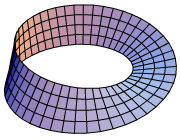Configuration space (physics)
Configuration space in physics
In classical mechanics, the configuration space is the space of possible positions that a physical system may attain, possibly subject to external constraints. The configuration space of a typical system has the structure of a manifold; for this reason it is also called the configuration manifold.
For example, the configuration space of a single particle moving in ordinary Euclidean 3-space is just R3. For n particles the configuration space is R3n, or possibly the subspace where no two positions are equal. More generally, one can regard the configuration space of n particles moving in a manifold M as the function space Mn.
To take account of both position and momenta one moves to the cotangent bundle of the configuration manifold. This larger manifold is called the phase space of the system. In short, a configuration space is typically "half" of (see Lagrangian distribution) a phase space that is constructed from a function space.
In quantum mechanics one formulation emphasises 'histories' as configurations.
Configuration spaces in mathematics

In mathematics a configuration space refers to a broad family of constructions closely related to the state space notion in physics. The most common notion of configuration space in mathematics is the set of n-element subsets of a topological space . This set is given a topology by considering it as the quotient where where is the symmetric group acting by permuting the coordinates of . Typically, is called the configuration space of n unordered points in and is called the configuration space of n ordered or coloured points in ; the space of n ordered not necessarily distinct points is simply
If the original space is a manifold, the configuration space of distinct, unordered points is also a manifold, while the configuration space of not necessarily distinct unordered points is instead an orbifold.
Configuration spaces are related to braid theory, where the braid group is considered as the fundamental group of the space .
A configuration space is a type of classifying space or (fine) moduli space. In particular, there is a universal bundle which is a subbundle of the trivial bundle , and which has the property that the fiber over each point is the n element subset of classified by p.
The homotopy type of configuration spaces is not homotopy invariant – for example, two lens spaces that are homotopy equivalent but not homeomorphic (in this case meaning simple homotopy equivalent) need not have homotopy equivalent configuration spaces, which can be detected by Massey products.[1]
See also
- Feature space (topic in pattern recognition)
- Parameter space
- Phase space
- State space (physics)
References
- ^ Salvatore, Paolo; Longoni, Riccardo (2005), "Configuration spaces are not homotopy invariant", Topology, 44 (2): 375–380, doi:10.1016/j.top.2004.11.002













